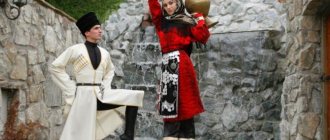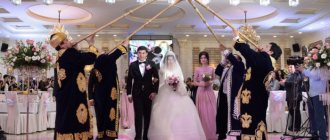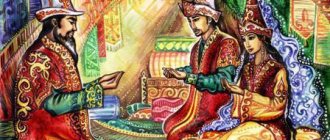A Spanish wedding is a unique celebration in which modern trends are closely intertwined with ancient traditions and customs, characteristic only of the inhabitants of this country. They are a reflection of the passionate Spanish soul, hot temperament and devotion to family values. This is what distinguishes celebrations in hot Spain from the rather restrained European weddings that everyone is accustomed to.
The Svadbaholik.ru portal offers a closer look at the unique customs and features of holding a wedding in bright and sunny Spain. Depending on the region of the country, traditions may differ from each other, but the basics of celebrations comply with established rules.
Spanish wedding dresses
Wedding traditions in Spain affect not only the ceremony, but also the choice of dress for the bride, which, by the way, is usually bought by the groom.
According to all the most ancient canons, the classic bride's dress should be black. In Spain, this color symbolizes love and devotion to one's husband until death. However, not everyone likes this now! Some girls, following custom, buy a white dress for themselves, but add black elements to it.
Most often, modern brides prefer a white outfit, less often - red. Many girls choose a wedding dress in the traditional Spanish style - flamenco, the distinctive features of which are both the style and the unusual diagonal cut. The fitted top of the dress, a fluffy skirt and an abundance of flounces emphasize the silhouette and add uniqueness to the bride’s image.
The founders of flamenco are the Spanish gypsies. As a result of the interaction of two cultures and traditions, an unsurpassed, vibrant and unique style emerged. Perhaps this is why the Spaniards celebrate weddings so magnificently and on a grand scale.
One of the most important details of a Spanish wedding look is the traditional lace veil - mantilla, which looks incredibly gentle and romantic.
Cost of a visa to Spain
| Type of visa requested | Length of stay | ||
| Citizens of the Russian Federation and the CIS | Citizens of other countries | ||
| Schengen multiple entry visa (type “C” visa) | 180 / 365 days | 3500 / 6500 / 9500 rub. | 9500 / 18500 rub. |
| National visa / residence permit (type “D” visa) | from 180 days | 9500 / 18500 rub. | 18500 rub. |
| Regardless of citizenship, service and consular fees are paid for a visa type “C” or “D” | |||
VISA ASSISTANCE +7 (495) 128-66-79
Spanish style wedding
Imbued with the spirit and traditions of a bright and sunny country, newlyweds from all over the world often want to add these special notes to their celebration. A Spanish-style wedding will be remembered for a long time not only by the young people, but will also leave pleasant memories for all guests. Good and interesting traditions will only brighten the holiday of love.
A wedding filled with touching rituals elevates the celebration to a sacred level. The symbolism of love and happiness surrounds the young. A riot of colors and fireworks of emotions create a unique atmosphere. The scale of the celebration in the Spanish style will not leave anyone indifferent.
To organize such a unique wedding, you don’t have to go to Spain. You just need to borrow the interesting traditions you like, add bright decorations, choose a themed wedding dress in the flamenco style - and your unforgettable holiday is ready!
The portal www.svadbagolik.ru is confident that anyone can organize a wedding even in the most unusual style, and a piece of magnificent Spain will make your holiday truly colorful and unique.
Wedding traditions in Spain
If anyone is interested, I have collected some information about wedding traditions in Spain (which, in principle, is similar to other countries):
WEDDING (LA BODA) IN SPAIN
If earlier each country had its own special wedding traditions, now all European-style weddings are similar. Many of the customs described below will seem familiar to you, since they are already international.
How to propose (pedir la mano)
According to custom, the groom's parents (los padres del novio) come to the house of the bride's parents (los padres de la novia). All expenses used to be borne by the groom's family. On the morning of this day, the groom must send his chosen one a bouquet (el ramo) of white flowers. The purpose of this meeting is to introduce families who are about to become related (emparentar) over lunch, dinner or just a cup of tea/coffee. Sometimes this event takes place in a restaurant, sometimes at home. The bride's parents sit at the head of the table, and the groom's parents sit to their right (the groom's mother is to the right of the bride's father, and the groom's father is to the right of the bride's mother).
On this day, future spouses exchange gifts in the presence of guests. Moreover, no one else should give gifts on this day. The groom, as a rule, gives his chosen one a ring (el anillo) with a diamond (or without). And the bride gives the groom a watch (el reloj), cufflinks (los gemelos) or a tie clip (el alfiler de corbata).
Rings
Wedding rings (las alianzas) are an integral symbol of marriage. The ring finger (el dedo anular) is said to be directly connected to the heart. The vein connecting them was considered the vein of Love back in Greece.
In Rome there was a method of the Holy Trinity (el método trinitario): the ring was put on each finger in turn with the words “In the name of the Father, Son and Holy Spirit” (“En el nombre del Padre, del Hijo y del Espíritu Santo”) and left it on ring finger.
The most commonly used ring material is yellow gold (el oro amarillo), although wedding rings are available in white gold (el oro blanco), silver (la plata) and platinum (el platino). On the inside of the ring you can engrave (grabar) the names of the newlyweds and the wedding date. Interestingly, in Spain there are no regulations on which hand the wedding ring is worn on: it depends on the region.
Even in Spain, the groom traditionally gives the bride 13 blessed coins (las arras) made of gold or silver measuring 1.5-3 mm in diameter. They once symbolized the groom's ability to feed his future family, or it was a ransom for her virginity. Now it is simply a symbol of the common property of the spouses. Sometimes coins are not bought, but received as a gift from the godmother (la madrina) or as an inheritance from the parents of the bride or groom.
Some wedding traditions
A few days before the wedding, the bride and groom usually have a bachelorette party (la despedida de soltera) and a bachelor party (la despedida de soltero), respectively. Few people now observe the tradition of collecting a dowry (el dote) for the bride.
By the way, in Spain, weddings do not take place on Tuesday 13th (martes, trece), as this day is considered unlucky. Let us remember the saying: “Martes y trece, ni te cases, ni te embarques” (Tuesday the 13th, neither get married, nor leave).
There is a custom to take eggs to the Clarissa nuns (llevar huevos a las Clarisas) so that there will be good weather on the wedding day.
It is believed that the bride should wear white (blanco) because they used to marry as virgins, and white is a symbol of purity and purity. By the way, in Andalusia, many girls choose a long dress in the flamenco style: with frills (volantes) at the bottom and a short bolero (abrigo corto de bolero). But a 100% Spanish dress should be made of black silk (seda negra). A traditional detail of a wedding dress (since the 17th century) is a lace cape (la mantilla de encaje), which the bride pins to her hair with two black combs (peines negros). It is often longer and heavier than a regular veil (el velo).
Before the wedding, the bride used to embroider (border) a shirt, which her future husband would wear to the ceremony.
On your wedding day, you should definitely wear something blue or dark blue (azul), something rented (prestado) and something old (usado). Blue symbolizes fidelity, strong long-term relationships. What is borrowed for a while symbolizes friendly ties. And a used, not new thing symbolizes that we do not forget the past, but remember it.
In Spain, no wedding is complete without orange blossom (el azahar) - white flowers (orange tree). The bride inserts them into her hair, they are present in the bouquet, as well as in flower arrangements on the banquet tables.
At a wedding, it is customary for the godfather (el padrino) to give a small gift to the male guests, usually a cigar (el puro). And the godmother (la madrina) gives some gift to the ladies present (previously it was cigarettes). For the unmarried girls who come, the bride prepares small brooches (el broche) with flowers, which they wear during the holiday: whoever loses it will marry next. Children are given treats or trinkets (chucherías).
When leaving the church, the newlyweds are sprinkled with rice (arroz) - this tradition came from Asia, and symbolizes hope for offspring J
The wedding ball usually opens with the dance of the newlyweds (waltz (el vals)). Some adhere to the tradition that first the groom dances with his godmother, and the bride with her godfather.
The bouquet (el buquet = el ramo) thrown by the bride to her friends who have reached marriageable age (casaderas) is a good way to share her happiness. The tradition originates in France; in the 14th century, it was believed that the garter (la liga) brings good luck, and so that all the guests would not chase after it, the bride began to throw it voluntarily. Then gradually the custom arose of throwing a bouquet to girls and a garter to boys.
The wedding cake (la tarta nupcial) came to us from Rome. Previously, a piece of bread was placed on the bride's head - a symbol of fertility and offspring. And the guests treated themselves to the pieces that fell. A multi-tiered wedding cake is already an English tradition.
The groom crosses the threshold of the house with the bride in his arms (cruzar la puerta con la novia en brazos), and the right foot must step first. They say that this tradition comes from the Goths, who, due to the lack of women in their settlement, “stole” them from neighboring villages, taking them away on horseback.
Honeymoon (la luna de miel) and honeymoon trip (el viaje de novios) - what would we do without them? Do you know why this is the honeymoon? The Teutones (los teutones) celebrated weddings under the moon (moon) and drank honey liqueur for several days after the wedding to restore strength.
A few days after the wedding, the newlyweds (los recien casados) can receive their Family Book (Libro de Familia) at the registry office (Registro Civil) - a legal document with information about the marriage, and their future children will also be entered there.
Useful links:
link - website with tips, ideas and other practical information for planning weddings (in Spanish)
link - another similar site with information on wedding topics (in Spanish)
link – video presentation about the royal wedding of Felipe (the future king of Spain) and Letizia in 2004 (in Spanish)
link - trailer for the Colombian comedy “Ni te cases, nit te embarques” (2008) (in Spanish)
PS. Based on materials from my newsletter link (when quoting, a link is required)
Fiancé visa to Spain – characteristics
- A short-term document, the validity of which does not exceed 3 months. If the applicant has previously frequently visited the countries of the Schengen Union and is financially solvent, the permit can be extended up to 6 months. The period of stay in Spain for applicants who have not previously been abroad is limited to the dates indicated on the tickets or in the invitation letter.
- Fee for consideration - 60 euros . An increased cost is charged due to document verification on both the Russian and Spanish sides.
- The application review period is 15 working days . If the seriousness of the relationship in a couple is in doubt (there is little documentary evidence), the applicant is required to undergo an interview at the consulate. If the couple has not met in person before, the visa may be refused without refund of fees and charges.











